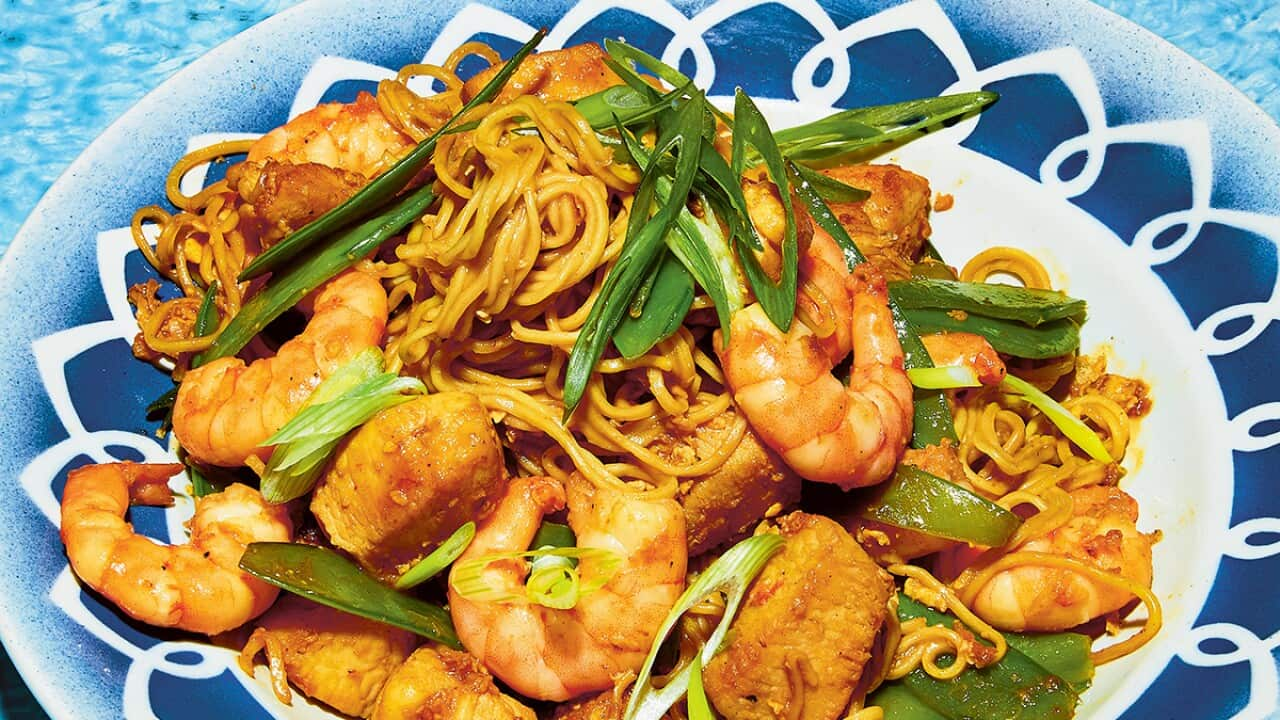Karina Utomo is best known by music fans as the vocalist for Melbourne-based heavy metal band High Tension.
"It's a medium that is so universal," says Utomo of music. "It's literally the language of the universe." But away from the stage, the Indonesian-Australian is committed to perfecting the art of Indonesian street food in her kitchen. Food, also, is a universal language and the one that provides a cultural and familial link between Utomo and her family.
But away from the stage, the Indonesian-Australian is committed to perfecting the art of Indonesian street food in her kitchen. Food, also, is a universal language and the one that provides a cultural and familial link between Utomo and her family.

Karina Utomo sings in the heavy-metal band High Tension. Source: Matt Walter
Utomo was born in the capital, Jakarta, where her father lives nearby. Her earliest memories of food include home food (masakan rumah) and food bought from vendors (jajanan). "The beauty of growing up in Jakarta is that there are always vendors going by on foot or bike with carts. Each of them has a unique jingle. For bakso, which is a beautiful tapioca, beef-ball broth, the bike vendors have a particular calling sound. Sometimes, you become langganan, loyal to a particular vendor."
Special occasion food might include nasi kuning tumpeng: yellow rice in the shape of a giant cone, "like a rice mountain" and wrapped in banana leaves.
"I asked mum to make that for my 12th birthday sleepover because it felt so festive," says Utomo. "It's normally served with tempeh and chillies, fried egg sliced thinly and delicate salads."
"I use ginger, bay leaf, turmeric, coconut milk and kaffir lime leaf to make yellow rice in my rice cooker. Roots and aromatics are the fundamental aspects of Javanese cooking."
A lot of the ingredients used in Indonesian cooking can't be found anywhere else in the world. "There's an abundance of diverse ingredients which are used creatively and meaningfully in Indonesian food. Kluwek, a type of nut, is used [in] rawon [a beef soup]. To use it, they bury it in charcoal until it goes dark, but it's got a really smooth, nutty flavour but the way they've treated it makes everything go black.
"When I think of Javanese flavours, it has all these layers that enhance all your senses. You smell it, then you feel that heat from ginger when you're eating it and the texture is unique too."
When I think of Javanese flavours, it has all these layers that enhance all your senses.
Utomo says if you can get the right ingredients, you can make Indonesian food at home. "I get my ingredients from a supermarket in Hawthorn called . They stock all the niche roots and nuts, including the kluwek. You can get candlenuts, white ginger that is in the same family as galangal (kencur), every kind of tapioca cracker, Indonesian brand toothpaste even! You can get all the varieties of rice, frozen banana leaves and specific Indonesian herbs and spices."
"I got ambitious on my birthday and made the West Sumatran dish, sate padang. Even my mum, who's an incredible cook, was so impressed. Most of the time, things have to be cooked more than once. It's laborious," warns Utomo. "If you are not enjoying the process with Indonesian cooking, the food will not be good."
To make sate padang, there's three different types of ginger, lemongrass, turmeric leaves, bay leaves, makrut lime and curry leaves, candlenuts, shallots, garlic, dried, fresh and powdered chillies amongst a long list of ingredients.
"If you're pressed for time, the cheat is to use a Nutribullet to make parts of this, but you need to cook the paste first, then you add the meat or tofu and the aromatics before you marinate all this. The broth becomes the sauce, that's the key to the sate padang."
Utomo says sate padang is very different from the Javanese peanut sauce-based satay.
"There are the same fundamentals to Javanese cooking, but West Sumatran dishes tend to use additional aromatics like cardamom and star anise. They're also fierier, they warm you up on the palate and in the chest. It's all the herbs and chillies, they're really energising," says Utomo.
"I would say sate padang is the extreme heavy metal of dishes."
Sate padang
Protein
- 500 g fresh beef
I like to use a combination of different cuts for texture and I tend not to remove the fat. Traditionally, beef tongue is also used for this dish, but I omitted it from this version as it's not much of a crowd-pleaser. The beef is to be seared before cutting into cubes, take care to not cut the pieces too small as it will shrink in size and will make it impossible to skewer or fall apart in the cooking process.
Vegan alternative
- Firm tofu with skin and use vegetable stock instead of water to make the sauce
Paste
Crush with a mortar and pestle, or use a blender/food processor if you want to take a shortcut.
- 5 fresh chillies. Remove seeds and placenta, adjust depending on your heat tolerance, ideally you should try to find the chillies from the Asian grocers, much tastier than birds-eye chillies from the main supermarkets.
- 5 dried whole chillies (soak in warm water, then remove seeds and placenta)
- 20-30 g of fresh turmeric (approx. 2 fingers in length)
- 50 g ginger (2 thumbs)
- 10-12 cloves of french shallots (or 210 grams of onion if you can’t find shallots)
- 6 cloves of garlic
- 8 candlenuts (you can find this at an Indonesian/Asian grocer)
Spices and more roots:
- 2 tbsp coriander seeds
- 1 tsp cumin
- 1 tsp ground chilli (I like to get the Indian dried chilli powder as it’s more aromatic)
- 1 tsp white pepper
- 10 cloves
- 2 pieces of star anise
- 4-5 cardamon seeds, remove the shell and crush the seeds
- 1 tsp cinnamon or 1 cinnamon stick
- 50 g fresh galangal (2 thumbs, slice and bruise with the pestle so it’s crushed but still a piece)
Leaves etc
- 2 stalks of fresh lemongrass
- 5 fresh makrut lime leaves
- 1 turmeric leaf (I used dried turmeric leaf)
- 3 bay leaves
- 80 g rice flour
Extras
- 1 L or so of water or broth
- Salt to taste
- Banana leaf, cut to a circle to line the plate for serving
- Fried shallots for garnish
- Tapioca garlic crackers
- Rice cakes or rice
- Before cutting into cubes, sear the beef in the pot with a bit of oil.
- Cut the beef into cubes & set aside, the beef will shrink in size as it will be slow-cooked with all the ingredients; so be mindful of that. You also don’t want the pieces to be too big as it will be hard to eat/cook and less flavoursome.
- Peel the shallots, garlic, turmeric, ginger & prepare the chillies & candlenuts for blending or crushing. The outcome should be a very smooth paste, you can use a blender/food processor or a mortar and pestle if you have the patience and want to build some muscle. If you’re using the mortar and pestle, the candlenut also serves a purpose to bind the ingredients, so you don’t get shallot or chilli juice in your eye(s); process everything bit by bit, slowly.
- Once the paste is ready, heat a bit of oil in a pan and let it simmer, it should smell really good. Pour yourself a drink for preparing and making that paste, the base of this dish!
- While it’s simmering, heat a small frypan and roast the coriander seeds & cumin, taking care not to burn it. I then crush these into a powder using a grinder/blender or a mortar and pestle.
- Add the coriander seed and cumin powder to the simmering paste and stir
- Add the dried chilli powder, clove, cardamom and star anise
- Add the sliced and bruised galangal
- Add the leaves (makrut lime leaf, turmeric leaves and bay leaves, plus the curry leaves if you have it but you can skip it)
- Chop into thirds and bruise the lemongrass, add to the mix
- Let it simmer for a bit longer so you can smell the aromas, I like to take this opportunity to taste a little bit of the paste, do not add additional stuff later - now is the time, it will compromise the balance as all components need to be cooked together.
- Once you're satisfied with the flavour, add the cubed beef (or tofu) from before, stir gently so it's immersed in the paste
- Add some salt (to taste)
- Add the white pepper
- You want to have the heat on low, with slight bubbling, close the pot and let it simmer like this for 10-15 minutes, keep an eye on it
- Add about a litre of stock or water now. I like to use homemade beef bone broth with no added salt. Take care if you are using stock as it can make the sauce too salty or add unideal extra flavours. Use unsalted vegetable broth if you’re making the tofu version
- You want to cook this for about an hour and test the tenderness of the beef / make sure the flavours have seeped into the tofu.
- Leave the whole thing to completely cool down/further marinate for 3-4 hours - if you're completing the threading onto sticks the next day. Chuck the whole pot in the fridge.
- Now, take care and remove the leaves & stalks from the mix
- Using a small strainer, remove the beef or tofu and set this aside
- Get another pot and strain the broth with a fine strainer to remove the clumpy aspects of the paste
- You can thread the beef or tofu to the skewers now, make sure that you pre-soaked the skewer sticks in water, so they catch on fire during the grilling process
- Tenderise the beef slowly by using your fingers and twisting each piece, as you're threading the pieces onto the sticks, you want to achieve a flatness to the shape of the satay stick for faster grilling. Have a bit of oil on hand and brush it on to the surface of the beef so you achieve a golden-brown finish in the grilling process. Brushing the oil also applies to the tofu version, but please don’t try to tenderise the tofu with your fingers.
- The final part of the cooking process is to thicken up the sauce with rice flour - have the rice flour aside in a separate bowl, add spoonful by spoonful of the broth and mix vigorously so it's a smooth consistency.
- Then add this rice flour/broth mix to the entire broth, while stirring, have the heat on low. You want to eliminate any clumps by having the heat not too high and being patient with stirring and the thickening process. Finished!
To serve
You can find frozen banana leaves at most Asian grocers as well as pre-packaged rice cakes.
Cut the banana leaf to the shape of a plate, cut the rice cakes, a few skewers of the beef/tofu sticks and generous amounts of the sauce you’ve lovingly laboured over. Finish off with fried shallots and tapioca garlic crackers!
INDONESIAN FOOD

Try this Indonesian drink, it's more than 1000 years old







